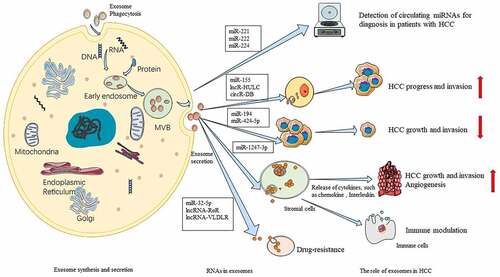Figures & data
Figure 1. Functions of exosomes in hepatocellular carcinoma development. Exosomes, which harbor proteins, mRNAs, microRNAs, long non-coding RNAs, circular RNAs, and DNAs, are involved in tumor microenvironment regulation, intercellular communication, immune modulation, cell differentiation, drug-resistance, and angiogenesis

Table 1. Overview of the roles of exosomal contents in HCC.
Figure 2. Roles of RNAs from hepatocellular carcinoma (HCC)-derived exosomes. Exosomes mediate the transport of various RNAs. Exosomes-associated miRNAs, such as miR-221, miR-222, and miR-224 can be potential diagnostic biomarkers for HCC. miR-155, lncR-HULC, and circR-DB promote HCC progression and invasion, whereas miR-194 and miR-424-5p suppress HCC growth and invasion. Exosome-associated RNAs, such as miR-1247-3p, which are transferred from the donor cells, can regulate stromal cells, such as cancer-related fibroblasts. The secretion of cytokines, such as chemokine and interleukins from the exosomes promotes HCC growth and invasion, including angiogenesis. miR-32-5p, lncRNA-RoR, and lncRNA-VLDLR are involved in the development of drug-resistance.Citation131Citation132Citation133Citation134Citation135

